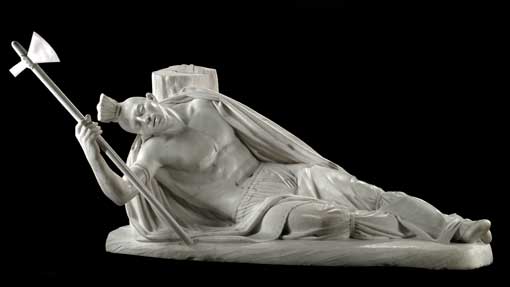Dying Tecumseh
Ferdinand Pettrich (1798–1872)
Marble with painted copper alloy tomahawk, 1856
Smithsonian American Art Museum, Washington, D.C.; transfer from the U.S. Capitol
In the fall of 1810, Tecumseh (1768?–1813) paddled down the Wabash River with four hundred warriors to meet Indiana territorial governor William Henry Harrison. Representing his brother, Tenskwatawa, Tecumseh demanded that Harrison return Indian land ceded in the Treaty of Fort Wayne.
When Tecumseh traveled south to enlist the aid of more tribes for his brother, Harrison—who had characterized him as “one of those uncommon geniuses”—took advantage of his absence to destroy Tenskwatawa’s encampment. Tecumseh then entered into an alliance with the British and was instrumental in forcing William Hull’s humiliating surrender at Detroit and other British victories in 1812.
In 1813, Tecumseh opposed the British retreat after Oliver Hazard Perry’s Lake Erie victory, leading to discord and Tecumseh’s death at the Battle of the Thames. Tecumseh’s reputation as a courageous warrior survived; only seven years later an Indiana newspaper proclaimed, “Every school boy . . . knows that Tecumseh was a great man.”

